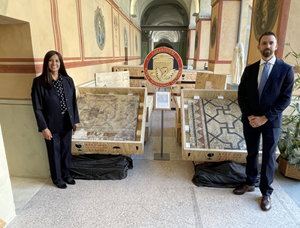
FBI Art Crime Team agents recently returned several pieces of historical artwork back to their rightful owners—the Italian government. This is the first in a two-part series.
When Special Agent Allen Grove joined the FBI Art Crime Team, he never thought shipping and logistics would be part of the job.
But that’s what it took for the team to return priceless artifacts—ones that may have been lost for as long as 100 years—back to their rightful home in Rome, Italy.
“I thought I’d be investigating art crime and repatriating antiquities. But so much of the work behind the scenes is communications, contracts, and getting the right items to the right people,” he said.
In late 2020, an art attorney reached out to FBI Art Crime Team Special Agent Elizabeth Rivas about an anonymous client who had a mosaic of the mythological figure Medusa. The enormous work had been cut into 16 pieces and stored in individual pallets in a Los Angeles storage facility since the 1980s. Each pallet weighed between 75 and 200 pounds.
Some of the pallets were termite-infested, but the pieces of the mosaic were largely intact thanks to the climate-controlled facility they’d been kept in.
The client had no documentation—known in the art world as provenance—so they could not sell the pieces. (Selling art without provenance is the equivalent of trying to sell a car when you don’t have its title.)
The mission for Special Agents Rivas and Grove became discovering where the mosaic belonged so the FBI could return it.
A local art expert said the mosaic was likely of North African or Italian heritage. So Rivas started with the FBI’s liaison in Italy.
A few months later, the FBI’s Italian counterpart, the Carabinieri, whose art squad frequently works with the FBI’s art crime investigators, confirmed the mosaic was Italian. It had been entered into cultural property records in 1909.
The mosaic is believed to be about 2,000 years old and is a key part of Rome’s history.
The only modern record of the mosaic’s existence was a 1959 newspaper ad that appeared to show it for sale in the Los Angeles area.
The next challenge was logistical. The mosaic had to be carefully packed and shipped in such a way that it would arrive undamaged. Luckily, the anonymous individual who had possession of the work agreed to pay for specialized shipping crates.
“We worked with the owner and made sure we documented the condition and had everything we needed to ship it back to Italy,” Grove said. “We then worked with the Italian consulate here in Los Angeles. This is something of great interest to Italy; they came and inspected the mosaic and helped us facilitate the logistics of actually getting it back to Italy.”
The art arrived safely in April, and experts are now working to clean and restore it so the art can be enjoyed by generations to come.
“The mosaic was handcrafted from an age where people put an amazing amount of care and effort into it. It really speaks to the ingenuity and creativity of the time,” Grove said. “It's not meant to be in Los Angeles. The mosaic belongs to the people of Rome. It allows us to understand a bit about the history of humans 2,000 years ago.”
The ability to work closely and collaboratively with the Italian government was key to the success of the repatriation, as was the willingness of the art lawyer to reach out to Special Agent Rivas about the piece.
“We were very happy they contacted us,” Rivas said. “If they hadn’t, it could’ve been in storage for another hundred years. It’s a successful example of how we can work together to get pieces back to where they belong.”

ArtDependence Magazine is an international magazine covering all spheres of contemporary art, as well as modern and classical art.
ArtDependence features the latest art news, highlighting interviews with today’s most influential artists, galleries, curators, collectors, fair directors and individuals at the axis of the arts.
The magazine also covers series of articles and reviews on critical art events, new publications and other foremost happenings in the art world.
If you would like to submit events or editorial content to ArtDependence Magazine, please feel free to reach the magazine via the contact page.